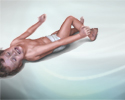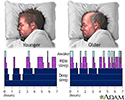Narcolepsy
Daytime sleep disorder; CataplexyNarcolepsy is a nervous system problem that causes extreme sleepiness and attacks of daytime sleep.
Causes
Experts aren't sure of the exact cause of narcolepsy. It may have more than one cause.
Many people with narcolepsy have a low level of hypocretin (also known as orexin). This is a chemical made in the brain that helps you stay awake. In some people with narcolepsy, there are fewer of the cells that make this chemical. This may be due to an autoimmune reaction. An autoimmune reaction is when the body's immune system mistakenly attacks the body's healthy tissue.
Autoimmune
An autoimmune disorder occurs when the body's immune system attacks and destroys healthy body tissue by mistake. There are more than 80 autoimmune d...

Narcolepsy can run in families. Researchers have found certain genes linked to narcolepsy.
Symptoms
Narcolepsy symptoms usually first occur between age 15 and 30 years. Below are the most common symptoms.
EXTREME DAYTIME SLEEPINESS
- You may feel a strong urge to sleep, often followed by a period of sleep. You can't control when you fall asleep. This is called a sleep attack.
- These periods can last from a few seconds to a few minutes.
- They may happen after eating, while talking to someone, or during other situations.
- Most often, you wake up feeling refreshed.
- Attacks can occur while you are driving or doing other activities where falling asleep can be dangerous.
CATAPLEXY
- During these attacks, you can't control your muscles and can't move. Strong emotions, such as laughter or anger, can trigger cataplexy.
- Attacks often last from 30 seconds to 2 minutes. You remain aware during the attack.
- During the attack, your head falls forward, your jaw drops, and your knees may buckle.
- In severe cases, you may fall and stay paralyzed for as long as several minutes.
HALLUCINATIONS
- You see or hear things that aren't there, either as you fall asleep or when you wake up.
- During hallucinations, you may feel afraid or under attack.
Hallucinations
Hallucinations involve sensing things such as visions, sounds, or smells that seem real but are not. These things are created by the mind.
 ImageRead Article Now Book Mark Article
ImageRead Article Now Book Mark Article
SLEEP PARALYSIS
- This is when you can't move your body as you start falling asleep or when you first wake up.
- It may last up to 15 minutes.
Most people with narcolepsy have daytime sleepiness and cataplexy. Not everyone has all these symptoms. Surprisingly, despite being very tired, many people with narcolepsy don't sleep well at night.
There are two main types of narcolepsy:
- Type 1 involves having excessive daytime sleepiness, cataplexy, and a low level of hypocretin.
- Type 2 involves having excessive daytime sleepiness, but no cataplexy, and a normal level of hypocretin.
Exams and Tests
Your health care provider will do a physical exam and ask about your symptoms.
You may have a blood test to rule out other conditions that can cause similar symptoms. These include:
- Insomnia and other sleep disorders
Sleep disorders
Sleep disorders are problems with sleeping. These include trouble falling or staying asleep, falling asleep at the wrong times, too much sleep, and ...
 ImageRead Article Now Book Mark Article
ImageRead Article Now Book Mark Article - Restless legs syndrome
Restless legs syndrome
Restless legs syndrome (RLS) is a nervous system problem that causes you to feel an unstoppable urge to get up and pace or walk. You feel uncomforta...
 ImageRead Article Now Book Mark Article
ImageRead Article Now Book Mark Article - Seizures
Seizures
A seizure is the physical changes in behavior that occurs during an episode of specific types of abnormal electrical activity in the brain. The term ...
 ImageRead Article Now Book Mark Article
ImageRead Article Now Book Mark Article - Sleep apnea
Sleep apnea
Obstructive sleep apnea (OSA) is a problem in which your breathing pauses during sleep. This occurs because of narrowed or blocked airways.
 ImageRead Article Now Book Mark Article
ImageRead Article Now Book Mark Article - Other medical, psychiatric, or nervous system diseases
You may have other tests, including:
- ECG (measures the electrical activity of your heart).
ECG
An electrocardiogram (ECG) is a test that records the electrical activity of the heart.
 ImageRead Article Now Book Mark Article
ImageRead Article Now Book Mark Article - EEG (measures the electrical activity of your brain).
EEG
An electroencephalogram (EEG) is a test to measure the electrical activity of the brain.
 ImageRead Article Now Book Mark Article
ImageRead Article Now Book Mark Article - Sleep study (polysomnogram).
Sleep study
Polysomnography is a sleep study. This test records certain body functions as you sleep, or try to sleep. Polysomnography is used to diagnose sleep...
Read Article Now Book Mark Article - Multiple sleep latency test (MSLT). This is a test to see how long it takes you to fall asleep during a daytime nap. People with narcolepsy fall asleep much faster than people without the condition.
- Genetic testing to look for the narcolepsy gene.
- Lumbar puncture (spinal tap) to look for low levels of hypocretin.
Treatment
There is no cure for narcolepsy. However, treatment can help control symptoms.
LIFESTYLE CHANGES
Certain changes can help improve your sleep at night and ease daytime sleepiness:
- Go to bed and wake up at the same time every day.
- Keep your bedroom dark and at a comfortable temperature. Make sure your bed and pillows are comfortable.
- Avoid caffeine, alcohol, and heavy meals several hours before bedtime.
- Don't smoke.
- Do something relaxing, such as take a warm bath or read a book before going to sleep.
- Get regular exercise every day, which can help you sleep at night. Be sure you do your exercise several hours before bedtime.
These tips can help you do better at work and in social situations.
- Plan naps during the day when you typically feel tired. This helps control daytime sleepiness and reduces the number of unplanned sleep attacks.
- Tell teachers, work supervisors, and friends about your condition. You may want to print out material from the web about narcolepsy for them to read.
- Get counseling, if needed, to help you cope with the condition. Having narcolepsy can be stressful.
If you have narcolepsy, you may have driving restrictions. Restrictions vary from state to state. Your provider may recommend that you avoid driving or other activities, depending on how well your symptoms are controlled.
MEDICINES
- Stimulant medicines can help you stay awake during the day.
- Antidepressant medicines can help reduce episodes of cataplexy, sleep paralysis, and hallucinations.
- Sodium oxybate (Xyrem) works well to control cataplexy. It can also help control daytime sleepiness.
These drugs may have side effects. Work with your provider to find the treatment plan that works for you.
Outlook (Prognosis)
Narcolepsy is a lifelong condition.
It may be dangerous if episodes occur while driving, operating machinery, or doing similar activities.
Narcolepsy can usually be controlled with treatment. Treating other underlying sleep disorders can improve narcolepsy symptoms.
Possible Complications
Excessive sleepiness due to narcolepsy may lead to:
- Trouble functioning at work
- Trouble being in social situations
- Injuries and accidents
- Side effects of medicines used to treat the disorder may occur
When to Contact a Medical Professional
Contact your provider if:
- You have symptoms of narcolepsy
- Narcolepsy does not respond to treatment
- You develop new symptoms
Prevention
You can't prevent narcolepsy. Treatment may reduce the number of attacks. Avoid situations that trigger the condition if you are prone to attacks of narcolepsy.
References
Avidan AY. Sleep and its disorders. In: Jankovic J, Mazziotta JC, Pomeroy SL, Newman NJ, eds. Bradley and Daroff's Neurology in Clinical Practice. 8th ed. Philadelphia, PA: Elsevier; 2022:chap 101.
Krahn LE, Hershner S, Loeding LD; American Academy of Sleep Medicine, et al. Quality measures for the care of patients with narcolepsy. J Clin Sleep Med. 2015;11(3):335. PMID: 25700880 pubmed.ncbi.nlm.nih.gov/25700880/.
Maski K, Guilleminault C. Narcolepsy: diagnosis and management. In: Kryger M, Roth T, Goldstein CA, Dement WC, eds. Principles and Practice of Sleep Medicine. 7th ed. Philadelphia, PA: Elsevier; 2022:chap 112.
Mignot E. Narcolepsy: pathophysiology and genetic predisposition. In: Kryger M, Roth T, Goldstein CA, Dement WC, eds. Principles and Practice of Sleep Medicine. 7th ed. Philadelphia, PA: Elsevier; 2022:chap 111.
Sleep patterns in the young and aged - illustration
Sleep patterns change with age, anxiety levels and many other factors. Normally, younger people have more concentrated periods of deep sleep compared to older people.
Sleep patterns in the young and aged
illustration
- Narcolepsy - InDepth(In-Depth)
Review Date: 8/28/2023
Reviewed By: Joseph V. Campellone, MD, Department of Neurology, Cooper Medical School at Rowan University, Camden, NJ. Review provided by VeriMed Healthcare Network. Also reviewed by David C. Dugdale, MD, Medical Director, Brenda Conaway, Editorial Director, and the A.D.A.M. Editorial team.


